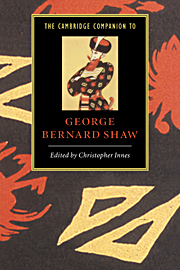13 - Shaw and the Court Theatre
from Part 3 - Theatre work and influence
Published online by Cambridge University Press: 28 May 2006
Summary
Introduction
In his introductory remarks to Lilian McCarthy's autobiography, Myself and My Friends (1933), Shaw wrote of the Court Theatre experience: “It did not seem an important chapter when we were making it: but now, twenty years after its close, it falls into perspective as a very notable one.”
When the Court Theatre venture was properly launched in the autumn of 1904 by Harley Granville Barker and J. E. Vedrenne, G. B. Shaw was' known as a minor novelist, a highly rated music and drama critic, and a failed playwright. A leading article in The Era (May 14, 1904) attributed his incontestable lack of success to his didacticism, his dehumanizing of characters, and his idiosyncratic egotism that revealed itself even more distastefully when his plays were performed rather than read. In March 1905, the leader in the same paper referred to “The Bernard Shaw Boom” at the Court Theatre. By 1907 when the Barker-Vedrenne partnership was planning a move to the larger Savoy Theatre after an artistic triumph and at least a respectable financial outcome at the Court, no less a theatrical knight than Sir Herbert Beerbohm Tree was extolling Shaw's virtues as a dramatist who had by this time been happily acknowledged by the presence of the King, the Prince and Princess of Wales, the Prime Minister, and numerous notable politicians at his Court productions.
- Type
- Chapter
- Information
- The Cambridge Companion to George Bernard Shaw , pp. 261 - 282Publisher: Cambridge University PressPrint publication year: 1998
- 1
- Cited by



